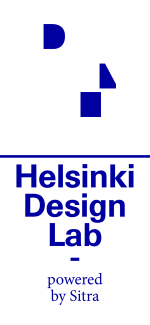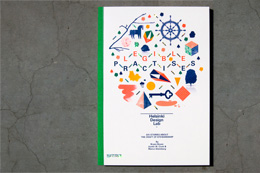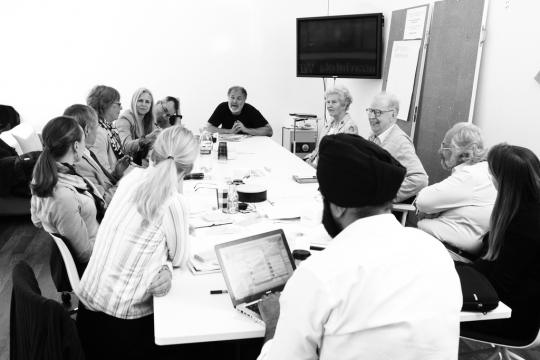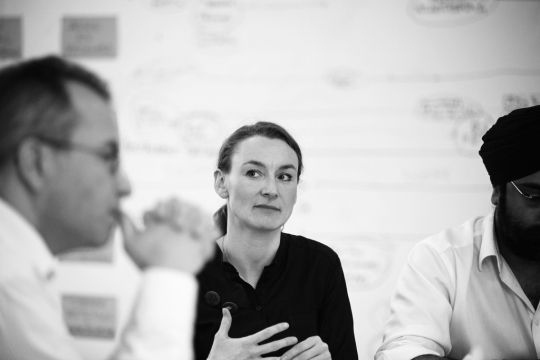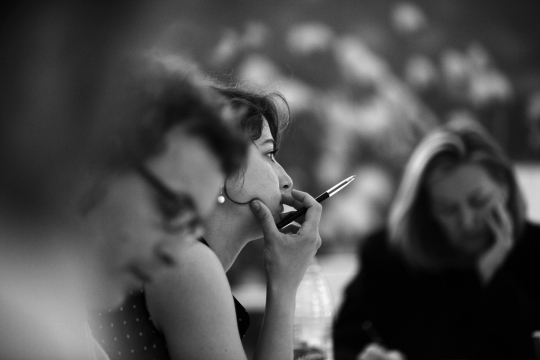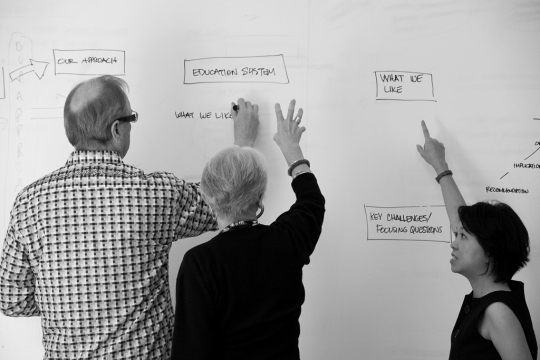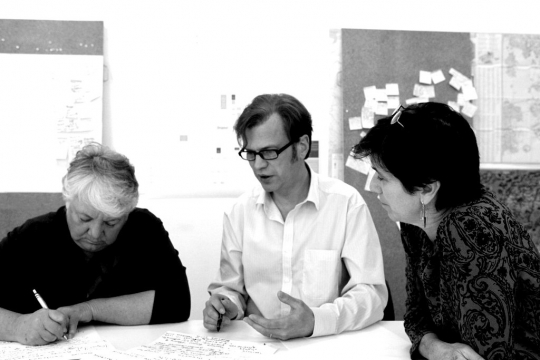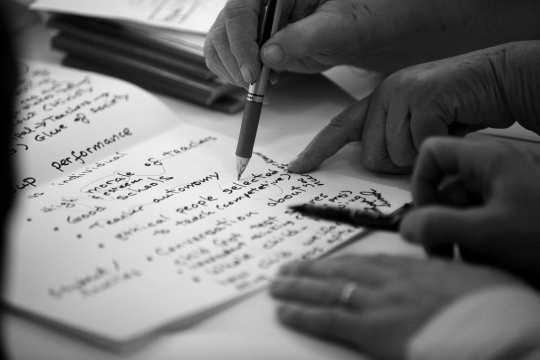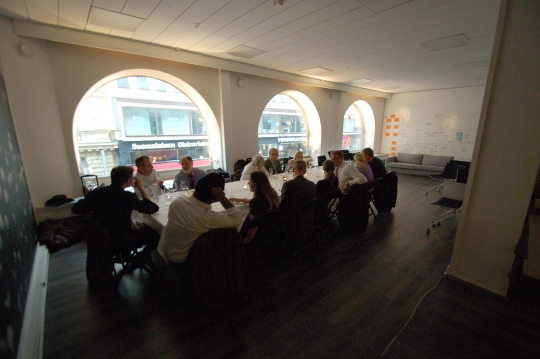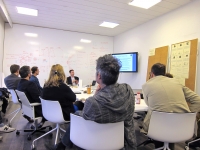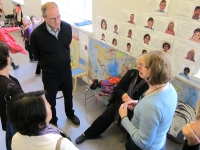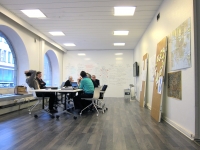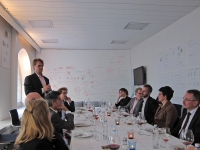Helsinki Design Lab helps government leaders see the "architecture of problems." We assist decision-makers to view challenges from a big-picture perspective, and provide guidance toward more complete solutions that consider all aspects of a problem. Our mission is to advance this way of working—we call it strategic design.
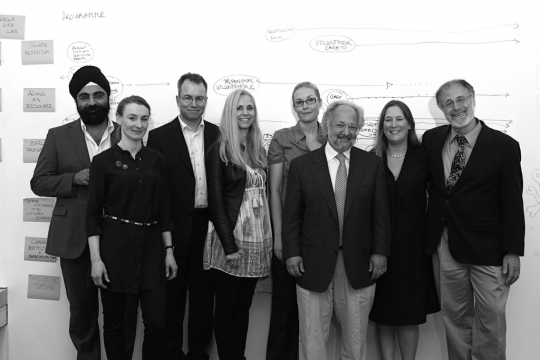
Left to right: Inderpaul Johar, Marianne Guldbrandsen, Petri Lehto, Onny Eikhaug, Hannele Seeck, Alberto Holly, Emily Thomas, John Ruark.

Helsinki's Deputy Mayor Paula Kokkonen joins the studio for the friday review.
And many more here on Flickr. Photos by Ivo Corda.
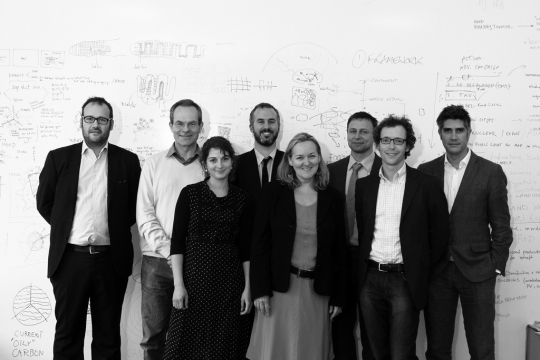
Left to Right: Federico Parolotto, Janne Hukkinen, Katharina Schmidt, Dan Hill, Patricia McCarney, Seppo Junnila, Matthias Rudolph, Alejandro Aravena.
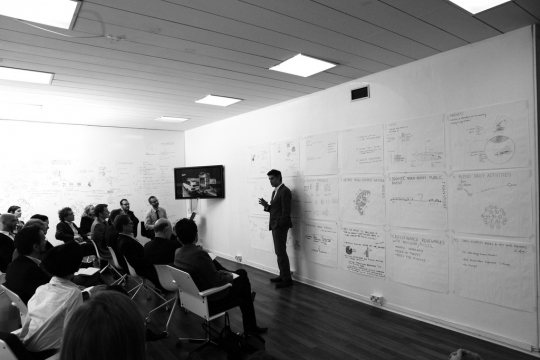
Alejandro presents the Studio's work
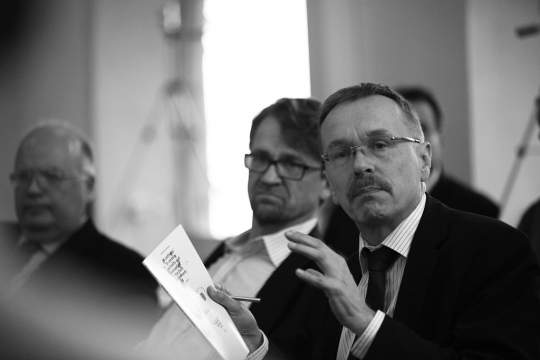
Timo Mäkelä, Director of Sustainable Development and Integration at the DG Environment of the European Commission, comments during the Friday review
With more photos on Flickr if you cant get enough. Photos by Ivo Corda.
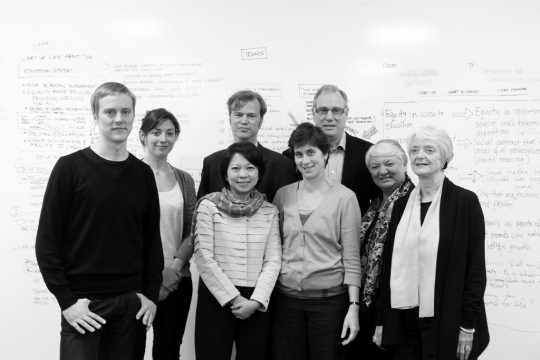
Left to Right: Roope Mokka, Maja Kecman, Lim Lai Cheng, Juha Teperi, Linda Nathan, Darrel Rhea, Ann McCormick, Jane Bernstein
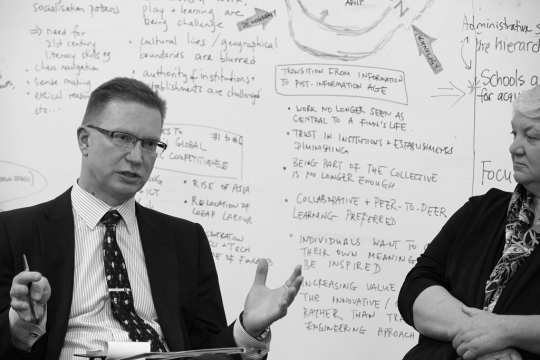
Timo Lankinen, director general at the Finnish National Board of Education, discussing the Studio's recommendations
More photos from the studio on Flickr. Photos by Ivo Corda.
Summer is in full swing here in Helsinki, which means that things are slow. Well, things are slow everywhere but HDL. Marco and I continue to narrow in on HDL Global, taking advantage of the empty calm of the office to talk through some scenarios without having to slice the conversation into between-meeting-sized chunks.

A temporary fruit orchard built in the heart of London as temporary nursery for plants and trees which will ultimately be gifted to local schools and community groups. Also home to Aalto University's Nest, sponsored by the Finnish Institute.
I started the week in London, where I was visiting the London Festival of Architecture to share some thoughts about design, complexity, and decision making informed by our work here at HDL.
Back in Helsinki we have things on the burner: working with XOXCO on a new part of this website, which will be helpful for sharing the work of the HDL Studios as well as supporting Studio-style work in the future; walking through HDL Global step by step with Emil+Stephanie to make sure that signage and printed material is designed for all of the needs, navigational, informational and otherwise; setting up contracts and schedule for some video work to kick off in early August; on the horn with Zurich to explore a potential new avenue for HDL.
We also put up a ton of images on Flickr. Over the next week we'll trickle some of those photos on the blog, but if you just can't wait to see you can find shots from all of our HDL Studios, most of which are by the talented Ivo Corda.
Posts tagged with "How-To" contain reflections on designing, organizing, and operating the HDL Studios, a series of three collaborative, multi-disciplinary problem solving experiments we held this summer. These posts are meant to be informative for others who may also be exploring ways to put the design process to use in new ways or those who find themselves struggling to work between disciplines or silos.
—
The best way to share ideas depends on the specific ideas and the audience you want to share with. In other words, the mechanisms of knowledge transfer are every bit as much a design project as is the development of whatever knowledge one aspires to share. This post is about some of the techniques we're using to share our work right now.
In the past, printed reports have been one of the dominant tools for sharing new information, be it research, analysis, or evaluation. For a number of reasons, these reports seem almost mandatory—or may even be legally mandated, depending on your organization's status. But what good is a report that no one reads? And how useful is a report that takes so long to produce it's out of date before the ink dries?
At this early stage in the work of Helsinki Design Lab we've taken a different path, which is to focus on conversations rather than reports. The printed (and online) documentation will come—we're beginning to work on them now—but at this stage the emphasis is on bringing people together with enough time, space, and quality input to have a good conversation.
Review
The model we used in the HDL Studios is based on the "final review" concept which is borrowed from design education. In design school, a studio is comprised of 10-15 students working on their own individual response to a project assignment which is issued at the beginning of the semester. There are interim "pin ups" every couple weeks where the whole studio gathers around to look at in-progress work literally pined up on the wall, while the professor critiques, or "crits" for short, the students' projects in terms of what's working and what's not. The culmination of the design school semester is a "final review" where students present their projects to a panel of 4-6 professors who offer a more substantial critique of the work. This discussion is where the ideas of the semester are teased out, compared, and tested.
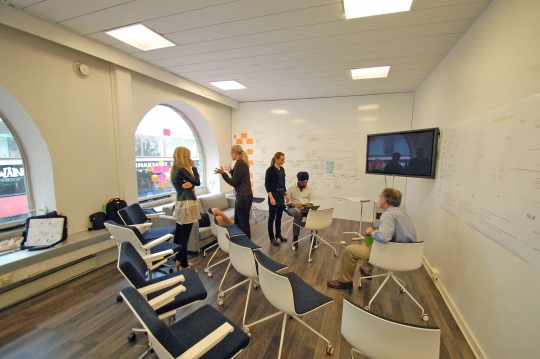
Finishing up slides just before the final review
An HDL Studio works collaboratively on a single holistic proposal and then shares its findings in a final review similar to that discussed above. Months before the studio started we were working to secure a group of 3-5 high level guests from Finland and Brussels who have a vested interest in the theme of the studio. Having the right audience who is both committed to the topic and acutely aware of the nature of the challenge is very important because it makes them good critics, and ultimately good champions.
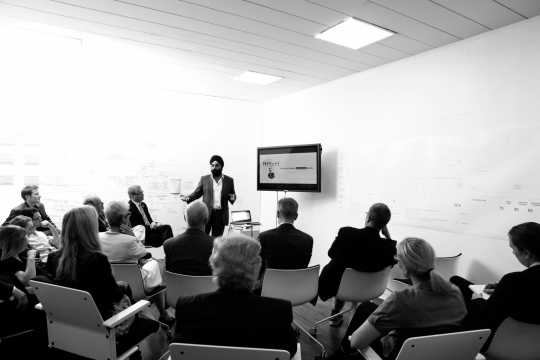
Indy Johar presents the HDL Studio on Ageing's findings. Photo: Ivo Corda
The studio gives a presentation of 30 minute or less sharing how they define the challenge, what opportunities they see, what barriers they perceive, and then outlines a collection of specific project ideas that coalesce into a "roadmap" towards strategic improvement. This is the synthesized outcome of their week in Finland and it may be accompanied by slides, videos, whiteboard drawings, handouts, or any other medium they see fit to use.
After the presentation concludes, we transition into a conversation. This is a moment where the specific nature of the physical space is very important. For these final reviews we pushed the main work table out of the way so that there's nothing between the person presenting and the audience. Once the formal presentation is over, the presenter can sit down and a conversation among peers flows easily. Would there have been a pedestal, table, or other barrier in between the interaction would be too rigid. Making these transitions seamless is important because they are the points where momentum can easily be lost.

As simple as it sounds, having the chairs in a circle really does yield a more active conversation
The worst thing after a presentation is to leave too little time for conversation, condemning what dialog does happen to be mere platitudes and clarifications. Since the two-way exchange of ideas during conversation is our focus in these review sessions, we leave ample time to discuss. In the case of the HDL Studios this summer we had 60-90 minutes of conversation after the review, which is just about enough to process some of the new knowledge which has been shared by the team.
Dinner
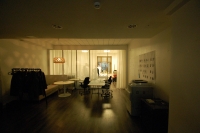
The research office doubled as a field kitchen for the catering staff
After a good stretch of discussion about the presentation, we transitioned again from the review to dinner. Since the studio table had been pushed out of the way, the catering staff could set the table for dinner while things were wrapping up. Having dinner in the studio space with the studio, our guests, and HDL/Sitra team members allows the ideas of the week to settle in through a different, more casual mood. It's both a celebration of an incredible week of effort and a real working dinner wherein the review conversation is revisited and continued. Perhaps most importantly, moving from the review to dinner allows us to spend more time together stewing on the ideas without resorting to an awkwardly long meeting.
By the time everyone leaves on Friday night, there will have been a good four to five hours of intense conversation around the recommendations of the studio team. Especially when dealing with strategic questions that are often complicated and messy, having a solid bit of time to properly talk through things is important. The danger of a short conversation without enough opportunity for back and forth is that the participants use the same words without ever sharing a common understanding. It's a fact that understanding takes time, and that's what the review/dinner pairing is designed to deliver.
Next Steps
We'll address next steps more specifically in an upcoming post, but while we're on the topic of the Friday knowledge transfer it makes sense to discuss a bit of the practicalities of how the conversation moves forward. If the review and dinner are about developing a sense of shared commitment and understanding, next steps arise out of shared opportunities. To help narrow down and specify the nature of those opportunities, HDL will continue the conversation with our stakeholders in Finland over the coming months. To aid this longer phase of discussion, the review and ensuing "critique" were recorded and documented in a summary pamphlet by the studio assistants. We designed the review/dinner from the point of view of what would make that experience as effective of a knowledge transfer environment as possible and then added into the mix a documentary capacity which can add longevity.
Sample schedule
- Months before review: identify and confirm guests
- Weeks before review: set up dinner and other logistics
- Friday 10:00: presentation "dry run" with Studio team and HDL to test the story and work out the bugs
- 15:00: move studio table and arrange chairs for review
- 15:45 guests arrive
- 16:00 presentation starts
- 16:30 presentation concludes and conversation begins
- 17:45 conversation slows down as people get hungry
- 17:50 a short toast before sitting down to dinner
- 18:00 dinner begins and the conversation continues, lasting as long as the table likes
A quick note from the week of juhannus in Finland, where the length of the days reach their maximum for the year and many people take a holiday.

This is what Helsinki looks like at 01:00 on juhannus. Photo: Maanmatonen on Flickr
We've begun a new series of posts that reflect on the HDL Studio experiences from this summer. Check out the first two bits on building the right team and making the most out of a single week. Up next we'll have a post on knowledge transfer, to be followed by further posts on the all the behind the scenes work that goes on to support the studios.
Work continues on many fronts. Amongst them: zeroing in on September, starting a new project related to this website, and continuing to scope out the evolution of HDL.
Goodbye, June!
Posts tagged with "How-To" contain reflections on designing, organizing, and operating the HDL Studios, a series of three collaborative, multi-disciplinary problem solving experiments we held this summer. These posts are meant to be informative for others who may also be exploring ways to put the design process to use in new ways or those who find themselves struggling to work between disciplines or silos.
—
Last time we discussed how to put together a great Studio team. The flip side of assembling a talented group of people is that they tend to be incredibly busy, meaning that we were lucky to get a solid week of their time.
In this short window of time, the studio members had to meet and get to know each other, acclimate to the culture and locality of Finland, soak up the specifics of the Studio challenge, and—oh yeah—they also needed some time to work together towards developing a holistic, integrated framework for thinking about the challenge and then document it in a way that would spur conversation. With only a week to accomplish all of this, we had to make every minute count.
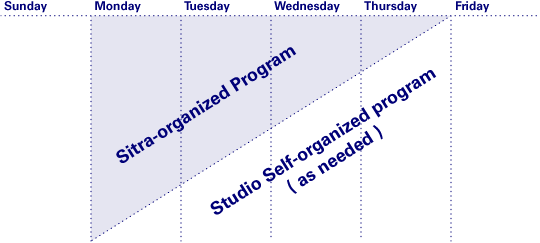
The basic outline of the week starts with stuff HDL arranged ahead of time and ended with a self-directed schedule
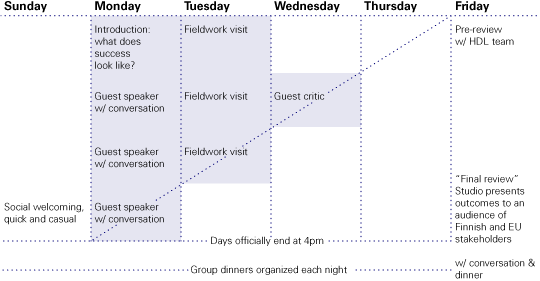
The actual schedule for each of the studio weeks was something like this
The general scheme for the Studio week started with Monday and Tuesday full of pre-arranged meetings and visits, trailing off to allow the team to define their own schedule in the second half of the week.
On Sunday we gathered for a very casual, quick dinner in the evening to welcome everyone to Helsinki and give them a chance to get to know one another. This ended early so that everyone could catch up on sleep before the busy week, some guests having traveled from overseas.
Mondays began with an introductory session where Marco shared a bit of material to explain "what success looks like" and give the studio and the studio members had another opportunity to introduce themselves and their thoughts on the challenge as outlined by the challenge briefing.
The primary goal of Mondays, however, was to give the studio a solid overview of the context that they would be working within. This was conveyed through a series of 3 or 4 guest lectures, each followed by a discussion period of about an hour. For example, the education studio had speakers talk about the socioeconomic development of Finland, the Finnish bureaucracy, classroom education and teacher education, and policing and prevention related to at-risk youth.
Tuesday of each studio was then spent in the field, out and about around Finland seeing first hand the reality of the challenge. To continue using the education studio as an example, this included visits to a primary school and a youth culture NGO.
Wednesday and Thursday were left relatively un-scheduled for the studio to self-organize and use as they saw fit. During each of the three studios we found that there were requests for additional meetings, so we were able to quickly arrange additional site visits or bring in more speakers on an as-needed basis. Meanwhile, the bulk of these days were spent in deep discussion and debate as the studio team developed a synthetic and holistic response to the challenge.
The ultimate target for the week was a "final review," a brief presentation and conversation with key stakeholders that occurred at the end of the day on Fridays. To help keep things on track, Marco and I sat with the studios on Friday morning to hear a dry-run and provide some feedback on the clarity of the story.
At 4PM on Friday, a group of 3-5 guests arrived and we pushed the conference table out of the way to make room for a presentation and discussion. Afterwards, we continued the conversation over dinner in the studio space, with the work of the studio's intense week covering the walls.
One week disappears very quickly during such an intense experience, and the teams were all very conscientious people who dedicated the entirety of their mental facilities to the challenge we gave them. As a mental 'steam valve' we set the end of the day at 4PM so that everyone could have a chance to rest or relax before dinner (typically at 7PM).
Dinners were pre-booked for each night of the week with the agreement that studio members could opt-out if they needed to rest. However, the majority of the dinners were with the full studios and this proved to be a very important venue for fleshing out ideas and developing the team's social bond. With only four days to really develop the bulk of the work, the Monday-Thursday meals represent a total of about eight hours of conversation—essentially another full work day.
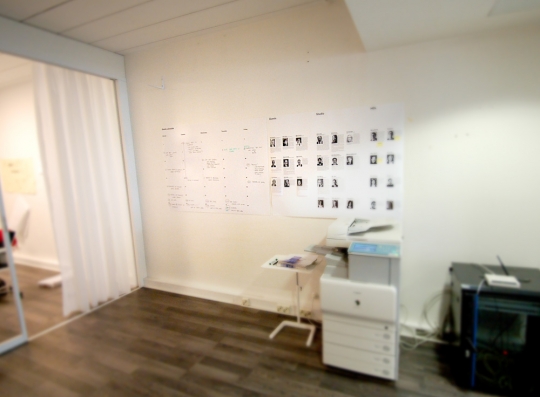
Our hightech solution to keeping the schedule up to date: a laminated poster and some whiteboard markers. We hung this live version of the schedule in a convenient corner of the studio
We also learned the hard way that it's very difficult to control a schedule that involves tons of moving parts. People change their arrival time, or become unavailable, things run late, etc. For this reason, the printed schedule that we handed out at the beginning of the week was just an overview, and we put up a wall-calendar which was updated as-needed the old fashioned way: with a marker.
Posts tagged with "How-To" contain reflections on designing, organizing, and operating the HDL Studios, a series of three collaborative, multi-disciplinary problem solving experiments we held this summer. These posts are meant to be informative for others who may also be exploring ways to put the design process to use in new ways or those who find themselves struggling to work between disciplines or silos.
This post is borrowed from Week 063's weeknote, which we've updated and expanded upon. Apologies for those who may have already read this entry.
—
One question we often get is "how do you pick the studio teams?" During the HDL Studio on Education someone went so far as to joke that they felt like they were participating in an Agatha Christie novel: a group of people are mysteriously pulled together out of thin air—why are they here and what will they do now? This post attempts to answer the first half of that question.
To begin, it's important to know that as the research for the Challenge Briefings developed, we created expertise profiles for each studio. These were running lists that identified what we consider to be key perspectives for each studio topic. This allowed us to target specific skill-sets and experience profiles.
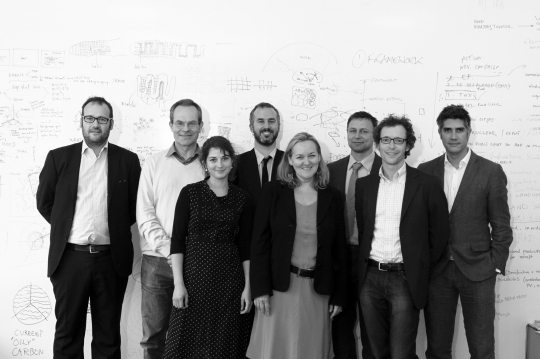
Sustainability, one of three studio teams from the summer of 2010
For instance, in the Studio on Sustainability we knew that building physics, transit, and policy would be essential areas. These are quite predictable. But we also sought some perspectives that might at first be unexpected. The thought behind this is simple: if you only include the regular suspects you will only get regular results. The notion of an "X-factor" can certainly go too far. For instance, although juggling is certainly an unexpected perspective for a conversation about sustainability, it's probably not the most relevant. The X-factor works best when it's someone who has a demonstrated commitment to the studio theme even if their everyday work does not 100% overlap with it.
We wanted the Studio to be as autonomous as possible so that their recommendations would truly be their own. For this reason we decided from the start that Sitra's role would be to support the studio rather than play an active role such as facilitating or otherwise being part of the Studio team.
Here are the basic rules of thumb that we used when thinking about the mix of the team and how to select the right individuals:
- Keep it small: With too few people there's a danger that conversation will not be robust enough, but with too many people in the room it's difficult to have a single conversation. Based on experience, and a bit of advice from Dan Goldin, a team of eight is optimal and we've now seen that it works very well. Some things work in large groups, but strategy sessions are not one of them. Eight is also small enough that you can fit into two cars. Although this seems like a small thing, the logistics required to smoothly pull off an event like HDL Studios are not to be underestimated.
- No room for duplicates: The studio team will be working quickly, which means that the collective expertise and experience in the room is the team's largest asset. Although team members may have some overlaps in their interests, it's best if each member is the master of their own domain and offers serious, focused expertise about their field. Each member becomes a 'representative' of their expertise and no one is redundant.
- Only accept the best: When it comes to selecting individuals, we've gone straight to the top. Across the board, we feel that the studio members we've attracted are either at the top of their respective fields or upcoming talents. High quality input may not quite guarantee high quality output, but it's certainly a prerequisite.
- Flexible expertise: It doesn't matter if you're the top expert on the planet in subject XYZ unless you're able to relate to others and convey your ideas in an open, productive manner. For this reason, we look for people who are at the top of their field, know their material inside and out, but are also naturally curious about the world around them and are able to sociably entertain models that conflict with—or even contradict—their own.
- Be (a bit) local: One of the great strengths of the HDL Studio format is that it offers a very fast and focused infusion of international expertise. But bringing in a wholly international group can lead to fruitless conversations when the cultural context is not understood. We set a rule of thumb for ourselves that two of the studio members would be Finns so there would always be 'cultural ambassadors' in the core team.
- Design is the glue: Each of the studios have two designers who work as facilitators amongst a group of peer-experts. It's their job to ensure that the conversation is balanced and holistic. Only a particular kind of designer will work in this context: they need to be able to apply their training to strategic issues. When recruiting the two designers for each studio we looked for one highly seasoned professional and one who was closer to the beginning of their career.
If these are the rules that guide our choices, one might ask how we first narrow the field. So far, the best indicator we have is that the kinds of people who succeed in collaborations with HDL are those who have significant experience in multiple cultures. Marco likes to use the term Third Culture Kid. This may be "culture" as it's typically defined or it may also refer to different cultures of expertise or work.
If I have the choice between an expert in astrophysics and an expert in astrophysics with a previous background in agriculture, my bet is on the latter. There's something about having lived in multiple cultures that prepares an individual for the kind of lateral thinking that is required in an HDL Studio.
Finally, the mix of the studio in terms of both expertise and personality is important. While one my be able to judge an individual's expertise by broswing a CV and reading some publications, it's very difficult to assess whether an individual will work well as part of a team unless you meet them in person. Sharing a phone call works too, but it's not as effective as having a face to face conversation with someone.
We also relied on our personal networks to recommend people who they thought would be right for this kind of experiment and followed up recommendations with phone conversations or, when possible, in-person visits.
For all of these reasons listed above, we devote a lot of time to sketching out the right mix for a team, courting a qualified pool of invitees, and working to secure their participation. As a reference, the process of defining the HDL Studio teams began eight months before the first studio, with the last three months of that period being the most intense. Without a solid team the entire Studio is moot, so it was worth it invest in taking the necessary time to ensure that the starting point would be strong.
This update comes from somewhere over the middle west of the United States, as I type away thanks to inflight wifi. Marco, Justin, and I have been in San Francisco for the Design Management Institute's Re-Thinking the Future of Design conference. Largely focused on the effectiveness of an expanded use of design within commercial organizations, Marco was sharing our work on a panel with Kyung-Won Chung from the Mayor's office in Seoul, South Korea, as well as Bruce Nussbaum, Roger Martin, and Jeanne Liedtka that discussed design in a larger societal context.
The event had a pretty good Twitter feed going and there were lots of lively discussions. The crowd skewed towards a more experienced, and thus older, level of individuals but it was nice to see some young faces in the audience as well. My eyes are especially attuned to these kind of demographics when I visit events these days.
With the HDL Studios and now HDL Global we've made a conscious effort to make space for younger voices in the conversation. Not only is the youthful perspective important, but we want to create opportunities to expose them to a new way of working and a new set of tools while they have an entire career ahead of them.
Speaking of students, this week concludes the work of Anna-Leena and Christina who have been supporting the ageing studio. Rather than work part time for a month, they compressed their work into a focused week-long charrette, which might explain the "brain self portraits" they drew.

Not sure what this says about HDL, but it's a fun exercise to draw a brain self portrait. Give it a try!
While in San Francisco, Justin and Marco managed to sneak in a couple Low2No working sessions with Arup and I paid a visit to Adaptive Path, where I had a chat with Peter Merholz about his growing design consultancy, and global design practice in general.
It was a good week and now we begin our laser focus on getting ready for September.
Last week was the HDL Studio on Ageing, our third and final for 2010. It was a lively, intellectually powerful five days spent in Helsinki and Jyväskylä and a perfect endcap to the HDL Studios experience. Here's a glimpse of our 2010 Studios by the numbers:
- 1 studio space
- 6 weeks
- 3 studios
- 24 studio Members
- 17 of which came from abroad
- 2 combined count of volcanos and labor strikes that our travel plans managed to survive without incident
- 7 studio assistants
- 25 guest speakers
- 7 Sitra organizers (either full or part time)
- 9 fieldwork visits by the studios
- 13 "final review" guests
- 18 group dinners
We'll be spending the next couple months wrapping up the work of the studios and determining the best way to proceed. If you're curious about the outcomes, please check back here, subscribe to our RSS feed, or follow us on Twitter. As soon as we have concrete news, it will be posted to this site.
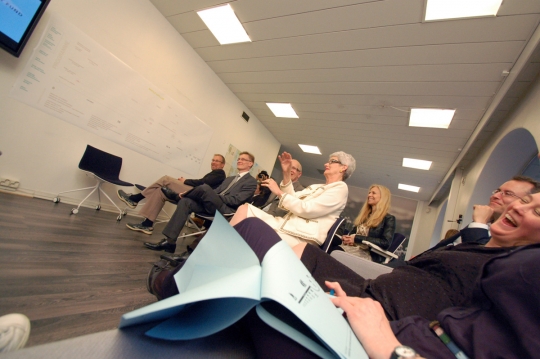
A snapshot from the Ageing Studio final review
With the studios now behind us, we've accumulated a body of strategic knowledge relevant to the three thematic topics of ageing, sustainability, and education, but we've also learned a lot about how one practices strategic design. During the summer months I'll be sketching out some basic thoughts about the experience and we'll hopefully have some guest blog posts from a few of the studio members as well. If you're interested in how to organize and operate a focused, fast, collaborative strategic environment stay tuned!
Since Helsinki Design Lab was re-calibrated as an initiative to foster 'government meets design' we've had three initial mini-projects. The first was this website, the second were the HDL Studios, and now our sights are set on HDL Global 2010, an invitational event this fall. So, in other words, tomorrow. Not that we're feeling the pressure or anything.
We've started to get a few little bits of press. The Talouselämä interviewed Darrel Rhea (printed in Finnish) when he was here for the Studio on Education. Linda Nathan wrote about the same week on her blog. Elsewhere, The World Changing Blog had some very nice things to say about us. We like you too, World Changing. And if you're the visual sort, Dan Hill has posted a whole heap of photos from his time in the HDL Studio on Sustainability.
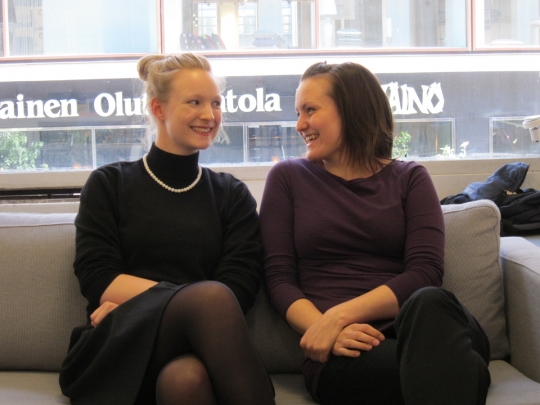
Taru and Kristiina were suspiciously happy about their last day at HDL.
All that's left for this week are some very important thank yous. Taru and Kristiina, two Aalto students who were the research team for the sustainability studio have completed their work, so we say thank you and goodbye to them. Thanks also to Adriel and Ezra, who longtime readers will remember as the primary researchers of the Challenge Briefings for our Ageing and Education studios. And finally, a very big thanks to Hanna, Minna, Sanna, Miku, and Seungho for their continuing contributions to the project. Without such a great team offering logistical, practical, and psychological support there's no chance that the HDL Studios would have come off as well as they have.
